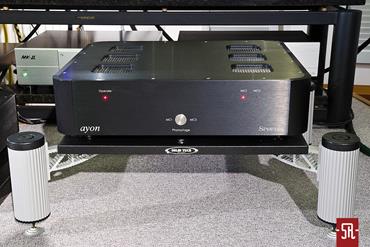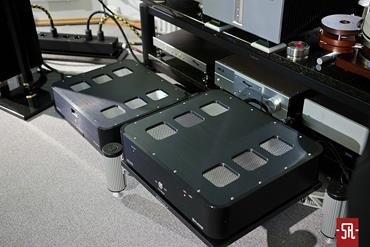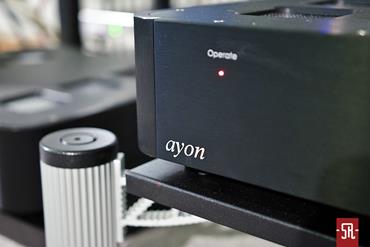Ayon Audio Spheris Phonostage Review – SoundRebels

AYON SPHERIS PHONOSTAGE ENGLISH VER.

The current trend of growing interest in vinyl resulted in more and more companies having a phonostage in their catalog. The bigger players in the branch have even more than one model, covering all price levels they operate on. Of course to be able to properly position a turntable preamplifier, it needs to be assessed in terms of sound quality; in general a more expensive unit should be more sonically advanced than the cheaper one. I have already gained some experience with very beefed-up constructions, and I have to say, that there were cases, when the sound quality did not correlate with the amount of money requested. This should not have happened in case of devices costing over 50000 zlotys, so if it happens we could talk about spoofing a potential client. Of course, when you look at what I wrote from the standpoint of an average citizen, even this threshold I mentioned, an amount, that would be sufficient to buy a medium sized car, may seem to be a hoax; but if you have the money, then you look at things differently. Finishing this, maybe a bit too long, introduction, I will just mention, that today we will have a meeting from the series “a turntable as your lives’ statement”, where I will confront my system with the top offering from the Austrian manufacture Ayon Audio, which is distributed in Poland by the Krakow based Nautilus (Eter Audio).
When I heard, that such a clash would be possible, I had lots of different thoughts, as often with top High-End offerings. Those were similar to those: what will happen, if this device will not be as good as expected? – it is tube based, and many audio constructors I know, told me, that this technology does not always work well nowadays, or: gosh, 110 thousand zlotys for a gramophone preamplifier, something that in many cases is just a expansion card inside a middle class integrated amplifier. Yet on the other hand, I knew, that such an experience will just be another very nice, or very disappointing, way of spending my time. So I decided not lose too much time thinking and just went to pick-up the phonostage for testing. Arriving at my destination I was a bit frightened, as I saw very big parcels, much larger than expected. I turned out, that those cardboard boxes are not bigger than necessary to avoid their contents being damaged by couriers, their contents was really quite big. Of course, like usual on this price level, the device is made-up from two cabinets – the power supply and the main unit, containing all the electronics. But this is nothing – when I placed them at their destination spots, my Reimyo power amplifier somehow disappeared. It still was higher, but occupied much less space, than the tested Ayon. Those two boxes are inflated to macro scale, but still have the shape and style recognized by every audiophile; brushed aluminum with rounded edges. Knowing that there are tubes inside, we can also find ventilation holes in the top cover, six in total, located near the edges. The front panels of both components are quite ascetic, the power supply only has a window displaying the regenerated mains frequency and a silver power button, while the main unit a switch selecting one of the two inputs – MC1 and MC2, and LEDs, on the left hand side indicating operation and on the right the selected input. The back plates are equipped in the following: the PSU with an IEC power socket, main power switch, phase control LED and a multi-pin connector for the umbilical connecting with the main unit, while the preamplifier has two sets of RCA inputs, a RCA and XLR output, grounding pin, ground circuit breaker and a socket for the power cable coming from the power supply. For adjusting the cartridge load, the constructor designed special jumpers, looking like an RCA plug. It has a certain impedance, and should be plugged into special sockets located next to the inputs. We get four sets of such jumpers, which should be sufficient, at least according to the manufacturer, to adjust the device to most cartridges used in the world. So there is nothing else for me to do, than continue to the most important part of the test, to find out, what this device, costing as much as a small apartment in Warsaw, is capable of, amplifying the tiny signal of the cartridge.
Due to the vacuum tubes used in the construction of this phonostage, each attempt at listening was delayed by at minimum 30 minutes of warm-up. This was not due to the fact, that the device sounded bad during that time, but from pure esteem to its construction. Knowing all its assets and shortcomings we do not need to wait that long, but me, just learning to know this device, had to allow it to reach its full potential before listening. And I must confess, that I needed a few days to reach my conclusions with this device, not because it sounded bad, not at all, but because I needed to confirm the very positive results that I achieved. Another confession I have to make is, that to date, I never met a good tube phono preamplifier. Of course I had some meetings with such contraptions, but they were not very expensive and they did not handle my expectations well enough, yet I rather account them to standard experiences than to big disappointments. They just played without too much ado, and because they were not overly expensive, there will always be someone who would find them interesting, especially when such people are just entering the path of the analog. But let us return to our Spheris. Plugging it into my system did not cause any shortage of breath in music. I will even say more – the amount of air on stage surprised even me, a very complaining audiophile, and this is the first thing that strongly determines my perception of an audiophile device. Freedom, sound detached from speakers and reaching the ears without any constraints were the result of incredibly good resolution. Of course changing from solid state to tubes resulted in changing the weight and timbre of the sounds, but this did not result in any slowdown of the attack, the sound just got more homogenous, slightly rounding off the contours of virtual sources. And it should be clear, that when somebody wants to listen to older vinyl issues, like I do, such approach will be very much appreciated. Older pressings are unfortunately often slightly deprived from weight, and this approach can be the cure for all “evil”, despite the fact, that it may be regarded as a departure from neutrality, when looked at it in absolute terms. However due to the usage of different versions of RIAA curves for pressing of the vinyls, this can be very hard to verify. I perceive the saturation proposed by Ayon as a good move, and because this is not a strictly technical solution, but a derivative of the used tube technology, it turned out to be very pleasant for my ears. Profiting from the slight timbre shift I moved to the shelf with Jan Garbarek, and chose the project with Charlie Haden and Egberto Gismonti called “Magico”. A saxophone, a guitar and a contrabass with some unobtrusive vocals, together with the Austrian idea of the analog, resulted in showing how good this old technology can sound. The homogeneity of the phrases was superb. The beautiful timbre of the instruments as well as its very readable positioning on the very deep stage allowed me to identify with the recording session created in my minds. But you do not live with timbre and smoothness alone, at least I do not, especially on the price level of 100 thousand zlotys and more. You do not know what I am talking about? Well, everything I wrote up to this moment should be satisfied by any well designed device, and we are testing the top of the top from Ayon catalog, thus the mentioned characteristics are the minimum of what it must master. But I will not weary anybody anymore and tell you, that any device belonging to the price stratosphere, regardless of what part of the audio chain it is, should enable the whole system to create an impression of three dimensionality of the sounds suspended in ether. Only this would be the state, that when fulfilled, would allow me to state with full conviction, that the potential buyer would not be misled. Of course, to be able to identify such situation two prerequisites must be met, a stereo system able to generate such phenomenon, and a listener, able to recognize it when presented. I know, that most readers are aware when such thing comes to existence, even more, they claim to have it every day when listening to their systems, but in reality they do not have a proper reference point and often overestimate the potential of their gear. Do I know everything? Am I infallible? Of course not, but I have some experience with incredibly costly stuff, and visualizations that came to life when listening to those, so I can come closer to assessing such aspects of the tested product. To be able to do that, I need to use appropriately recorded material, which mastered by a skillful sound engineer, is able to generate a kind of 3D spectacle in the area defined by the speakers. This part of the test took most of my time – of course from the moment I decided to search for it. With all respect to the constructor of the Spheris, this was not because it was lacking anything, but because I have a similar sound every day at home. It was only when had the opportunity to listen to a much lesser system, that I realized this truth. Having such a good standard at home in some way negatively influenced my capability to recognize this kind of visualization. Probably this last sentence would define me as being “narcissistic” if not for the fact, that some manufacturers, really knowing they ways in audio, were surprised, how my Japanese set presents the sound. Having said all that, I took the solo disc from Dino Saluzzi titled “Andina”, which allowed me to feel like watching the “Avatar” movie. Due to the perfect mastering of that disc, the loudspeakers create a harmony that reaches from one speaker to the other and allows us to have a deep look inside. This is a very interesting experience, but often overlooked by music lovers, who just accept it as part of what is happening on stage. This title brings us also closer to the end of this very positive encounter, as I would not have much more to say in addition to what was already mentioned. I will just underline, that regardless of what material was played (from old rock – Led Zeppelin to electronics – Massive Attack) the Spheris did not have any kind of shortage of breath, it just smoothened it out a little. A tad of timbre from the vacuum tubes seemed to amend the musical phrases that initially lacked homogeneity, presenting music in a more saturated way, more acceptable for the human ear. Of course that, what for me is a very important aspect of making sound digestible, may be too colored for others, but vinyl is all about such esthetics, and Ayon only tries to support it.
With relief I would like to praise the tested product for demonstrating to non-believers, that you can make a good tube phonostage. Maybe in very transparent systems, you would hear some artifacts related to the usage of tubes. My system, which is very transparent, but mostly timbre oriented, did not show anything like that. The tonal balance was somewhat lower than with the Theria, but this is an absolutely acceptable change, and in some systems may even be a desired one. I perceived the additional amount of timbre as a positive solution, what confirmed, that this is a very universal device. The slightly thickened outline of the virtual sources, their higher weight, treble touched with some warmth and full midrange give the full spectrum of assets expected from the analog sound source. If this is something for everybody, I do not know, but one thing I know for sure – you will not know for yourselves, unless you try it out. The high price may be a constraint, but if someone has the needed money, but believes, that the phonostage is the least important part of the analog chain, he or she may be very surprised after a listening session. In addition, two inputs, that I mentioned while describing the product, is currently a rarity, but may be a very nice thing for people having two-armed turntables (with for example one stereo and one mono cartridge). The timbre of the reproduced sound, which appears without any constraints or limitations to its resolution, is just another asset. I do not know how you see it, but for me the only “issue” with the Ayon product is its price tag, which is the result of its splendid sound, but may limit the number of potential buyers. But nobody said, that the life of an audiophile is easy.
Jacek Pazio
Ayon Audio USA – 1-800-676-1085 Ext 2
Technical details:
Class of Operation: Pure Class A, Triode
Tube Complement: 6H30, 6SL7
Maximum Output (at 1 kHz ): 5V rms
S/N ratio: > 96 dB
Output Impedance: ~ 300 Ohm
Frequency Response / Phono: 10Hz – 150 kHz
Harmonic Distortion (at 1V ) Phono: < 0.1%
Input: 2 x Phono RCA, 2 x Load
Output: 1x RCA, 1x Bal XLR
AC~ ReGenerator: max. 300 W
Frequency: 60Hz
Dimensions Pre (WxDxH): 50x43x11 cm
Dimensions ReGenerator P.S. (WxDxH): 50x43x11 cm
Weight (Pre & Power Supply): 38 kg
Electronics Reimyo:
– Separate DAC + CD player: CDT – 777 + DAP – 999 EX
– Tube preamp: CAT – 777 MK II
– Solid state power amp: KAP – 777
Speakers: Bravo Consequence +
Power cables: Harmonix X-DC-350M2R Improved Version
Speaker Cables: Harmonix HS 101-EXQ (mid-high section); Harmonix HS-101 SLC (Section woofer)
IC RCA Harmonix HS 101-GP
Digital IC: Harmonix HS 102
Table: Rogoz Audio
Accessories: Antivibration stand for the power amp by Harmonix TU-505EX MK2, Harmonix Enacom improved for AC 100-240V; Harmonix Tuning Room Mini Disk RFA-80i
Power distributor: POWER BASE HIGH END plus with Acrolink 9500
Analog stage:
– Turntable:
drive: Dr. Feickert Analogue „Twin”
arm: SME V
cartridge: Dynavector XX-2 MK II
Phonostage: RCM THERIAA












